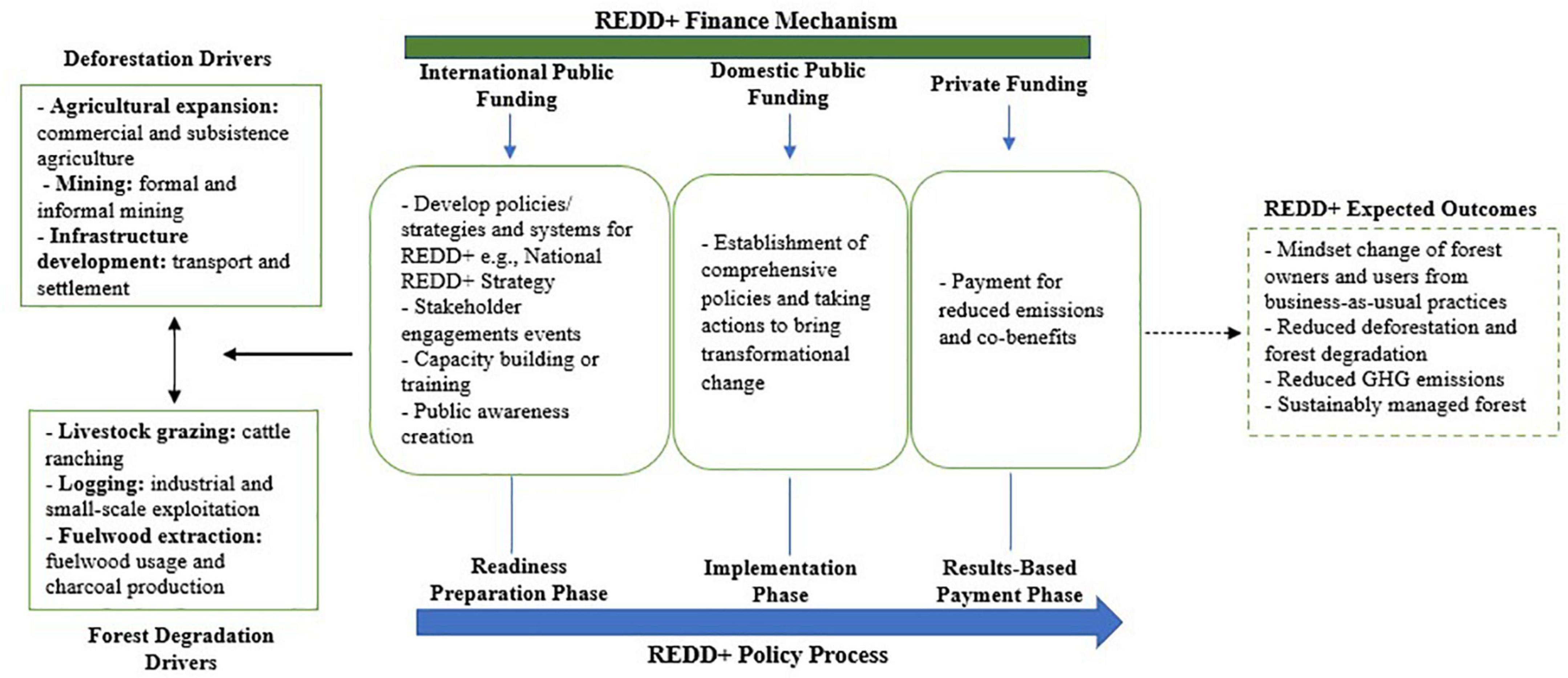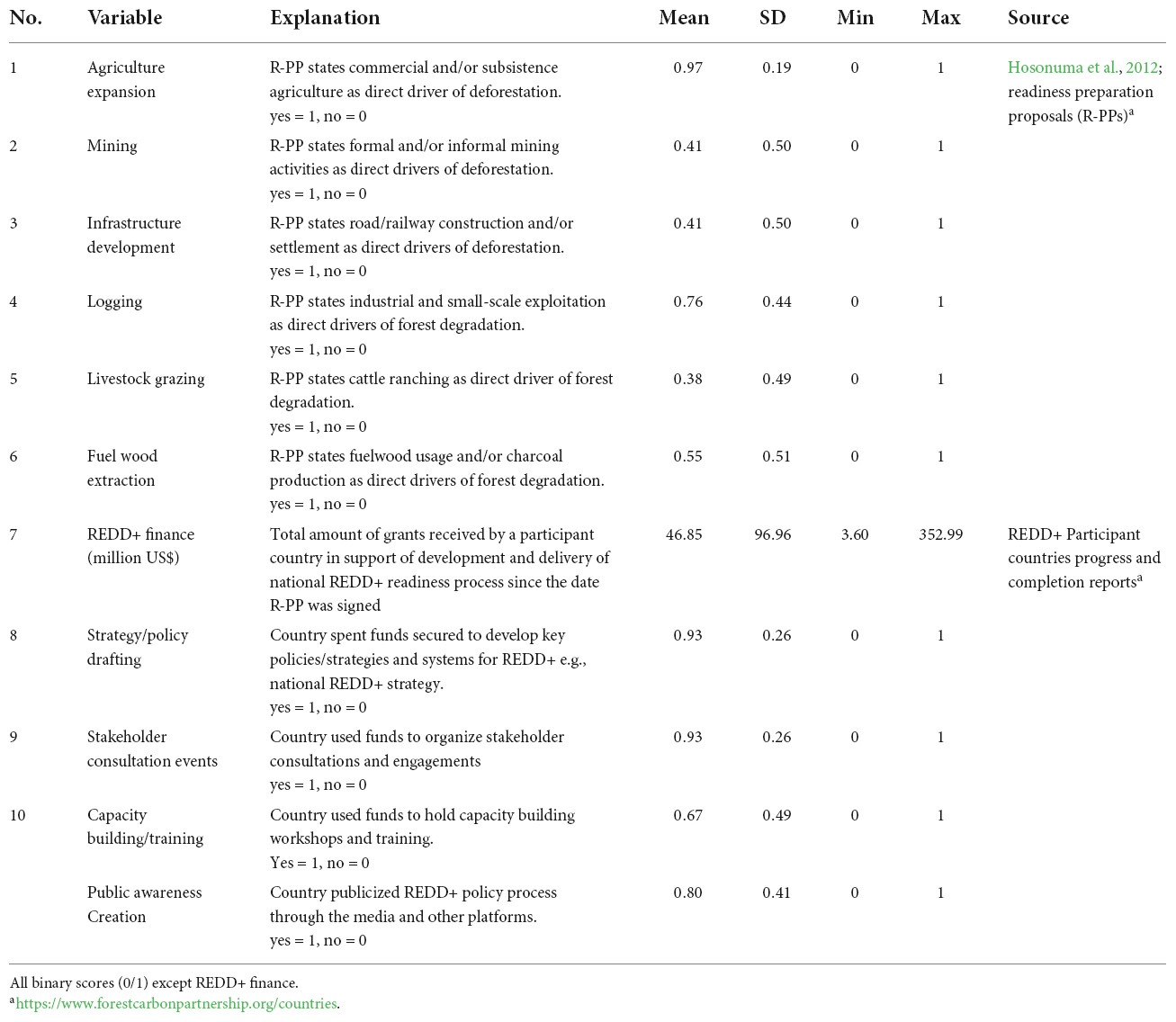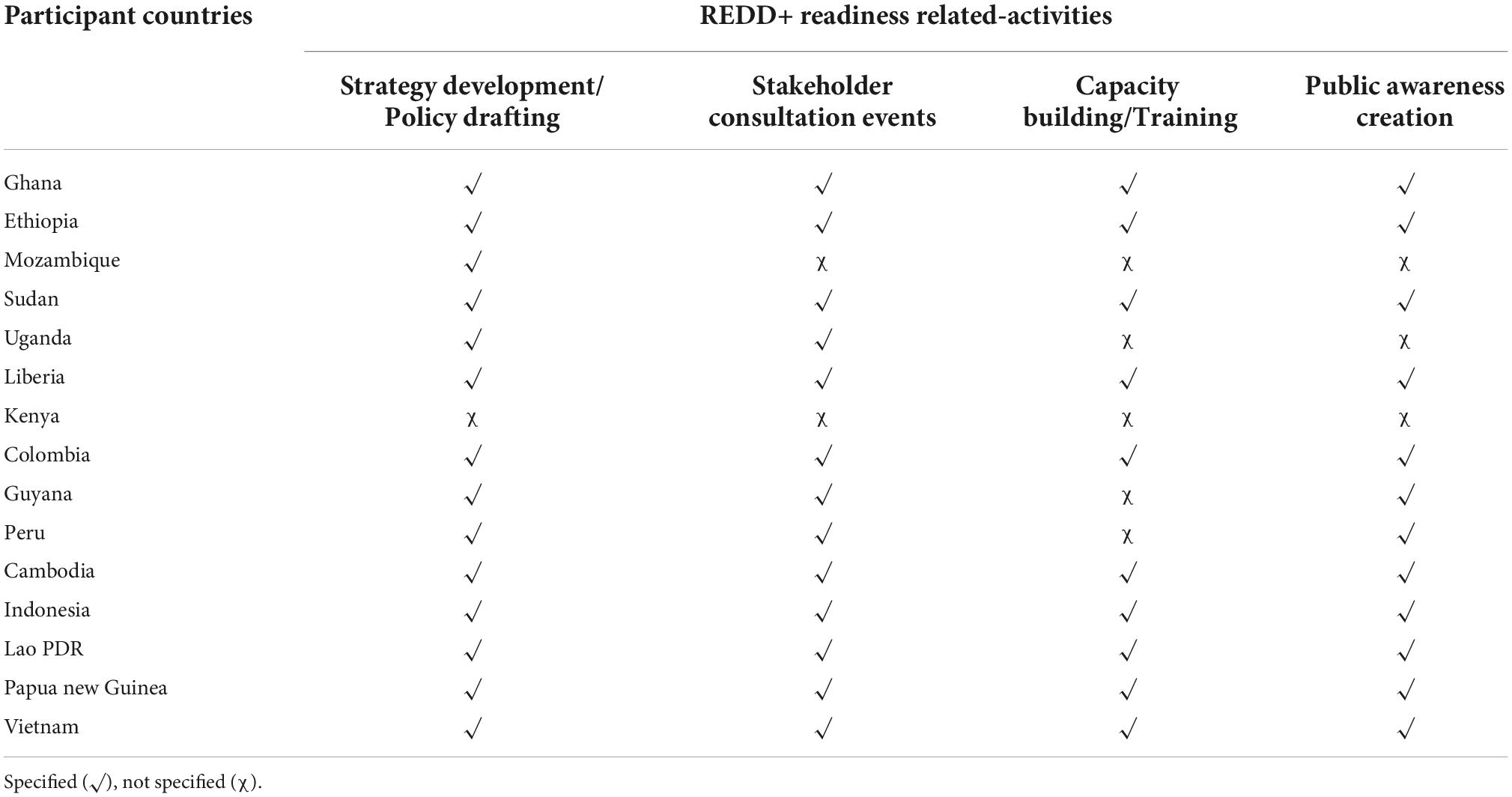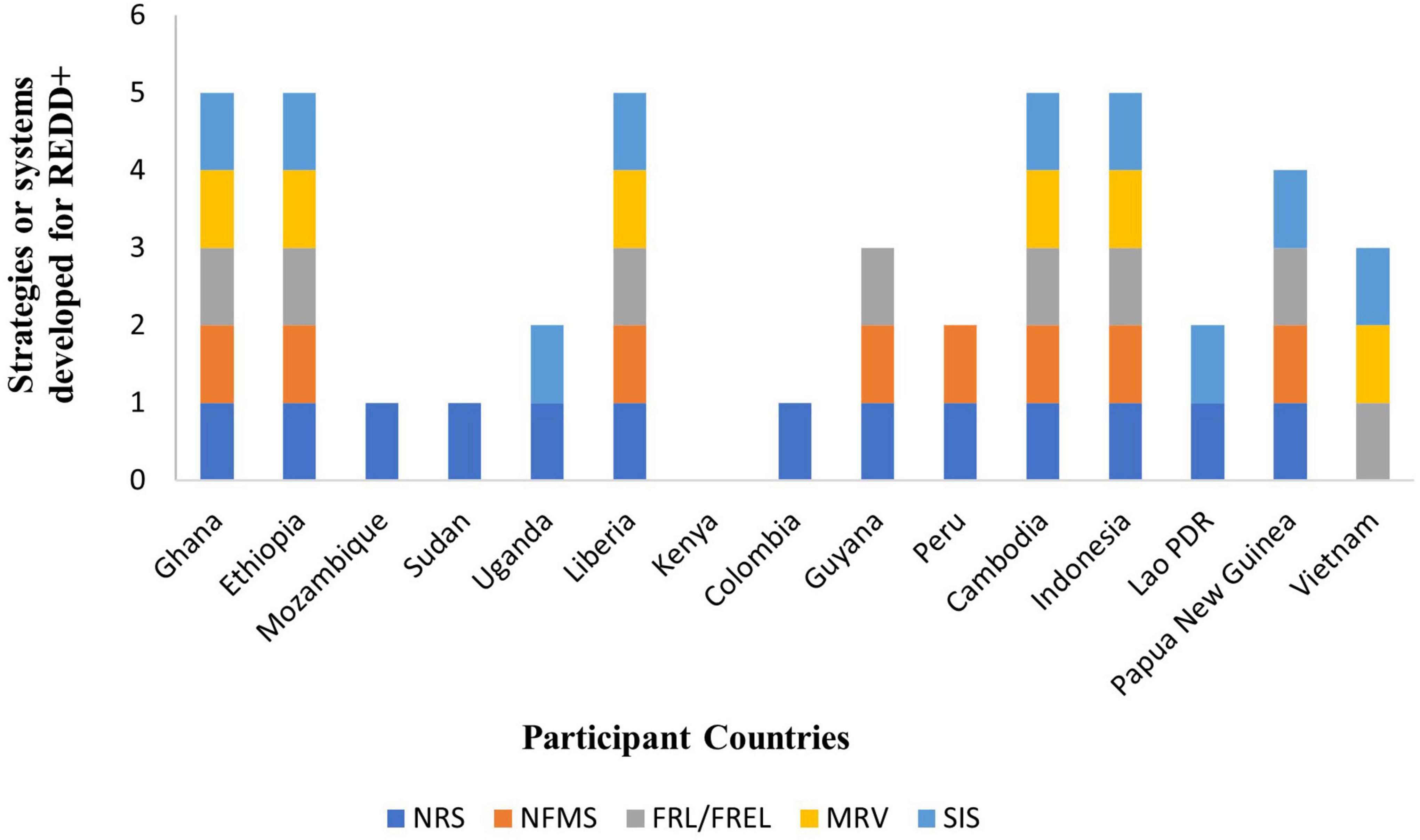- 1CSIR-Forestry Research Institute of Ghana, Kumasi, Ghana
- 2School of Forestry Sciences and Landscape Architecture, Kyungpook National University, Daegu, South Korea
- 3Department of Agriculture, Forestry and Bioresources, Seoul National University, Seoul, South Korea
This study provides an assessment of dominant drivers of deforestation and forest degradation across 29 REDD+ participant countries and total funds disbursed from the Forest Carbon Partnership Facility to 15 participant countries since they signed their respective Readiness Preparation Proposals (R-PPs), as well as what they spent the grants on. This study aims to provide information for policymakers and donors on the need to invest in REDD+, as well as the need for participant countries to channel funds to key activities for effectively and efficiently implementing REDD+. The assessment is based on participant countries’ R-PPs and FCPF readiness fund progress reports, using a content analysis approach. The expansion of agriculture, which includes both commercial and subsistence agriculture, was the predominant driver of deforestation, while logging, such as industrial and small-scale exploitation, was the main driver of forest degradation in most participating countries. In addition, we observed that the 15 participant countries received a total of USD 702.36 million for REDD+ readiness preparation. However, most countries have received less than USD 10 million for their readiness-related activities. We observed a huge disparity regarding the funds received between countries from sub-Saharan Africa and their Asian and Latin American counterparts, particularly Indonesia and Peru, respectively. Furthermore, almost all countries have spent their funds on policy and strategy development, stakeholder and consultation events, and public awareness creation. Relatively small amounts have been spent on capacity building and training. Thus, international donors need to focus on strengthening institutional capacities and building effective forest governance structures in countries participating in REDD+, and they should also provide platforms to engage with participant countries to tackle the main deforestation and forest degradation drivers. We suggest further studies to identify high-performing countries that have received lower-than-average funding, consider their deforestation pressures, the size of forests, and the emission reduction potential.
Introduction
Forests are an essential natural resource for mitigating climate change. They absorb and store carbon dioxide (CO2) in their biomass, thereby reducing the carbon content in the atmosphere, which in turn stabilizes the climate (IUCN, 2021). Unfortunately, forests worldwide face alarming depletion and loss owing to deforestation and forest degradation. This situation has led to many countries, especially in the tropics, losing their forest biodiversity and ecosystem services and contributing to elevated global greenhouse gas (GHG) emissions. Approximately 12% of carbon emissions from 2000 to 2009 were attributed to the conversion of forests to other land uses (Fischer et al., 2016). Land use change has also contributed to climate change, leading to desertification and land degradation (IPCC, 2020).
Deforestation and forest degradation are global environmental problems affecting humanity. In tropical developing countries, forests serve as a means of livelihood and wellbeing for the local people. Many of these countries are converting their forests for subsistence and commercial agriculture, mining, livestock grazing, fuelwood processing, and road construction. For instance, Ghana has converted approximately 135,000 ha of its forest annually for cocoa plantation expansion (Andoh and Lee, 2018). In addition, Papua New Guinea lost approximately 0.3 million ha of forest land to crop land, while commercial logging caused approximately 2.43 million ha of forest loss (PNG R-PP, 2013).
The alarming rates of deforestation and forest degradation in developing countries have taken a center stage in high-profile global deliberations. These discussions have resulted in several international conventions, protocols, and interventions to address these issues and achieve sustainable forest management. For example, in 2007, in Bali, Indonesia, the United Nations Conference of the Parties introduced a new climate policy regime, known as REDD+, to slow the rate of deforestation and forest degradation, reduce GHG emissions from forests, and increase their removal from the atmosphere in developing countries.
Many developing countries (hereinafter called participant countries) interested in implementing this global climate policy have undergone the preparation phase, which includes the development of readiness preparation idea notes (R-PINs), readiness preparation proposals (R-PPs), and the national REDD+ strategy (NRS) (UNFCCC, 2010; Minang et al., 2014; Andoh and Lee, 2018; Ochieng et al., 2018), but they are yet to implement and receive results-based payments. Nevertheless, REDD+ is unable to address the proximate causes of deforestation, such as agricultural expansion for palm oil, soy, cocoa, and coffee (Karsenty and Ongolo, 2012; Weatherley-Singh and Gupta, 2015; Bastos-Lima et al., 2017) due to the lack of effective management at the national level, poor governance structures, and stagnation of climate change negotiations (Cadman et al., 2017; Hein et al., 2018).
Since the inception of the REDD+ policy, participant countries have received bilateral and multilateral financial support to build capacity for the REDD+ mechanism and to provide compensation to forest owners for potential losses relative to its implementation (Angelsen et al., 2018). However, funds disbursed to participant countries vary greatly; Brazil received USD 1,408 million, while Ethiopia received USD 13.2 million, Ghana USD 29.4 million, Liberia USD 14.57 million, and Mexico USD 22.45 million, from 2009 to 2014 (Silva-Chávez et al., 2015). Silva-Chávez et al. (2015) argued that approximately USD 6 billion was disbursed to 13 tropical developing countries, including Brazil, Tanzania, Ecuador, Vietnam, the DRC, Colombia, Papua New Guinea, Indonesia, Peru, Ethiopia, Liberia, Ghana, and Mexico, which is considerable to finance REDD+ globally, but it falls short of the global estimate of USD 20 billion per annum to reduce deforestation. Olesen et al. (2018) found that some REDD+ participant countries such as Cameroon, the DRC, and Venezuela lacked the capacity to access international funds to scale up REDD+ processes to address deforestation drivers, increase forest cover, and reduce emissions due to weak governance structures and little engagement with major international donors funding REDD+.
Against this backdrop, we examine the main drivers of deforestation and forest degradation in participant countries, total REDD+ funds received from international donors, and how they are being used on the ground to support readiness preparation to curb the identified drivers. Our study seeks to answer the following research questions: (i) What is the main deforestation and forest degradation driver in REDD+ participant countries? (ii) What is the total amount of REDD+ funds disbursed to participant countries since they signed their R-PPs? (ii) What REDD+ -related activities are the participant countries spending the funds on? Our findings have a limitation to represent the whole amount of REDD+ funds but include a significant portion of the global REDD+ funding for readiness managed by the FCPF. These findings provide information and understanding to policymakers and donors on the need to invest in REDD+, as well as the need for participant countries to channel funds to key activities for effectively and efficiently implementing REDD+.
Drivers of deforestation and forest degradation in developing countries
Deforestation refers to the conversion of forests to non-forests or other land uses because of the interactions between both direct and indirect drivers, while forest degradation is considered to be an alteration in the structure of a forest, which reduces its capacity to provide environmental goods and services. The drivers of deforestation are “direct or indirect activities or actions at the forest frontier that impact forest cover” (Andoh and Lee, 2018). Direct drivers are anthropogenic or human activities and actions that directly impact forest cover, leading to the loss of carbon stocks, whereas indirect drivers are social, economic, and political factors that influence the direct drivers of deforestation and forest degradation.
Studies on deforestation and forest degradation drivers are vast but present diverse findings (see Geist and Lambin, 2001; Hosonuma et al., 2012; Kissinger et al., 2012; Pacheco et al., 2012; Weatherley-Singh and Gupta, 2015). Hosonuma et al. (2012) observed that over 70% of the direct drivers of deforestation are commercial and subsistence agriculture, whereas forest degradation is mainly due to logging and fuelwood extraction. Others argue that logging primarily causes deforestation (Laporte et al., 2007), and population growth (Jha and Bawa, 2006; DeFries et al., 2010), income and literacy rate (Andoh et al., 2018), subsistence farming, and the extraction of fuelwood (Brink and Eva, 2009; Fisher, 2010; Boucher et al., 2011; Sanford et al., 2011) drive deforestation. Weatherley-Singh and Gupta (2015) observed that agriculture conversion, logging, fuelwood extraction, roads and infrastructure, mining, forest fires, land tenure and ownership, and poverty are drivers of deforestation and forest degradation. However, predictors of deforestation and forest degradation vary across countries and change over time (Rudel et al., 2009; Boucher et al., 2011).
With controversies surrounding deforestation and forest degradation drivers, it is useful to obtain policymakers’ perspectives on the key drivers of deforestation and forest degradation for appropriate policy responses (Wehkamp et al., 2015). Wehkamp et al. (2015) presented a content analysis of African policymakers’ perceptions of deforestation drivers, relying on the R-PPs of 18 countries. They found that institutional and policy drivers were strongly emphasized. In this study, we expanded the analysis of policymakers’ perspectives on deforestation and forest degradation drivers according to importance across Africa, Asia-Pacific, and Latin America/Caribbean regions. Owing to insufficient funding for REDD+ in recent times, it is prudent to prioritize the key and important anthropogenic causes of deforestation and forest degradation at the national level for more attention and appropriate action.
Some studies on the drivers of deforestation and forest degradation have focused on regional case studies (Geist and Lambin, 2001, 2002) or continental and global scales (DeFries et al., 2010; Rademaekers et al., 2010), with less attention on a national scale (Kissinger et al., 2012). In this study, we draw attention to the predominant drivers of deforestation and forest degradation in each REDD+ participant country for strategic actions.
REDD+ financing
REDD+ seeks to provide economic incentives to developing countries to halt forest cover losses and reduce carbon emissions. This requires adequate and predictable financial support to cover the costs of the policy processes and actions that may bring the necessary change in the forest sector (Streck, 2012), including compensation to forest owners and users, which will be potentially affected in the course of REDD+ implementation.
REDD+ finance is one of the key components of the UNFCCC Warsaw Framework, which stipulates results-based payments; market and public funding sources; and transparent, accountable, and predictable management of funds for REDD+ (UNFCCC, 2009; Atela et al., 2016; Andoh and Lee, 2018). Andoh and Lee (2018) revealed that many REDD+ countries have developed strategies consistent with the funding requirements of the UNFCCC. However, donor funding for countries to progress from preparedness to implementation is inadequate. Only countries that take risks in the early stages of the REDD+ program have obtained readiness funds to assess the drivers of deforestation and forest degradation (Angelsen et al., 2018), to have broader consultations and engagements with stakeholders on discussions and the development of national REDD+ strategies (Duchelle et al., 2017), and to build capacity and establish national measurement, reporting, and verification (MRV) systems (Romijn et al., 2015). Unfortunately, countries that recently joined the REDD+ program, such as Angola, Bahamas, Palau, Rwanda, and Saint Vincent and the Grenadines, are competing for limited funds from multilateral mechanisms for readiness preparations (Angelsen et al., 2018). This is likely to hinder the progress of these countries, but such delays should not deter them from taking action to halt deforestation and forest degradation drivers if climate change mitigation is to be achieved.
Most REDD+ funding projects and activities come from bilateral and multilateral sources. Bilateral funds cover two thirds of all official donor agencies for REDD+ activities (Streck, 2012), while multilateral funds for REDD+, on average, cover approximately 29%, managed by the World Bank, the UN-REDD+ Programme, the Global Environment Facility, and the Green Climate Fund (Norman and Nakhooda, 2014; Angelsen et al., 2018; Olesen et al., 2018). Norway tops the chart of countries with the most disbursed funds (EUR 1,130 million) for REDD+ from 2008 to 2015, followed by Germany (EUR 356 million), the UK (EUR 189 million), the US (EUR 78 million), and Australia (EUR 71 million) (Silva-Chávez et al., 2015; Angelsen et al., 2018; Olesen et al., 2018). Global estimates show that approximately USD 15 billion per year is required for REDD+, which is more than the current funds available, about USD 1–2 billion (Norman and Nakhooda, 2014).
Participant countries require substantial funding from both domestic and international sources for the effective implementation of REDD+. However, some countries face challenges in accessing international funds for REDD+ because of their governance structures, MRV capacities, drivers and risks, and forest characteristics (Angelsen et al., 2018; Olesen et al., 2018). Angelsen et al. (2012) mentioned that the assessment of costs and financial needs of REDD+, mobilization of sufficient funds from donor agencies both internally and externally, efficient, effective, and equitable allocation and disbursement of funds, and matching REDD+ requirements and needs among stakeholders are challenges confronting REDD+ finance. The inability of most countries to access sufficient funds from international sources may stall REDD+ progress. However, countries such as Vietnam, Indonesia, Ecuador, and Ethiopia have mobilized domestic resources to shoulder part of the funding gaps for REDD+ activities (Angelsen et al., 2018). Some studies (e.g., Angelsen et al., 2012; Streck, 2012) suggest that countries should have diverse sources and ways of financing REDD+, such as private investments and domestic sources at the national, sub-national, and local levels. Although we subscribe to suggestions for both domestic and international sources of funding for REDD+, we argue that countries need to look beyond REDD+ finance, especially from international sources, which are bedeviled with challenges, and build social capital and forest governance systems to combat the drivers of deforestation and ultimately achieve REDD+. This is because provision of funds alone both internally and externally may not directly address the different drivers of deforestation and forest degradation, but rather facilitate the processes established for tackling them.
Recent studies on REDD+ finance have examined the challenges of donor funding for REDD+ (Angelsen et al., 2018), the effectiveness of REDD+ countries in attracting donor funding for REDD+ -related activities (Olesen et al., 2018), trends of REDD+ finance flows to 13 REDD+ countries from to 2009 to 2014 (Silva-Chávez et al., 2015), and the status quo and potential sources of REDD+ finance (Streck, 2012). Silva-Chávez et al. (2015) focused on the amounts committed to REDD+ countries, percentages disbursed from 2009 to 2014, and the proportion of 877 donor initiatives supporting various REDD+ activities. Nevertheless, there is still a gray area in the literature. Therefore, we relook at the funds thus far received by countries participating in REDD+ and the readiness activities they have spent the monies on. This would help streamline the funding regime and provide policy directions for REDD+ implementation.
Conceptual framework
In this study, we investigate the key drivers of deforestation and forest degradation specified in participant countries’ R-PPs, which the countries are determined to address, and whether funds received by these countries for REDD+ are tied to the progress made. This is significant because, as participant countries are determined to mitigate climate change, deforestation and forest degradation drivers need to be identified and prioritized for appropriate policy actions and funding. Thus far, most participant countries have received international public funding for the REDD+ preparation phase, which is to develop policies and strategies such as the national REDD+ strategy (NRS), a national forest monitoring system (NFMS), forest reference level/forest reference emission level (FRL/FREL), MRV, a safeguard information system (SIS), organizing stakeholder engagement events, organizing capacity building and training, and creating public awareness to be ready for full implementation and results-based payment (Figure 1). The implementation and results-based payment phases are also financed by multiple funding sources, including international and domestic public and private funding. The implementation phase involves the establishment of robust institutional mechanisms and taking actions of the REDD+ policy to bring about transformational change (Brockhaus et al., 2015), while the results-based payment phase deals with the achievement of reduced emissions and co-benefits by participant countries. According to Angelsen et al. (2018), financing REDD+ from various sources will cause behavioral changes in forest owners and users, leading to sustainable forest management, forest conservation and protection, emission reduction, carbon stock enhancement, and, ultimately, climate change mitigation. This study only assessed funds secured for REDD+ readiness-related activities since most participant countries are yet to see full implementation; thus, we limited ourselves to the preparation phase. We argue that participant countries could work more effectively and efficiently during the REDD+ readiness and implementation phase to achieve meaningful outcomes if both international organizations and governments are able to provide sufficient funds. Huge funding will aid the effectiveness of REDD+ activities in participant countries as they comply with the UNFCCC Warsaw Framework and other decisions, which provide assurance for the effectiveness and efficiency of REDD+ implementation.
Methods and data
In this study, we used content analysis (both qualitative and quantitative), which is a systematic approach for analyzing text sources and capturing tendencies in texts (Mayring, 2000, 2014; Wehkamp et al., 2015; Fischer et al., 2016). We adopted the steps described by Fischer et al. (2016) for analysis. These steps include (1) definition of material, (2) direction of analysis, (3) differentiation of subcomponents of the problem, (4) techniques of analysis, (5) analytical steps through category system, (6) rechecking category system, and (7) interpretation of results.
First, we analyzed documents from 29 developing countries that participated in the REDD+ policy process (Appendix A). These 29 countries account for over 80% of the global tropical forest cover. To better understand and identify the key drivers of deforestation and forest degradation, we conducted content analysis of their R-PPs. R-PPs are documents submitted to the Forest Carbon Partnership Facility (FCPF, 2017) and/or the UN-REDD+ Programme by participant countries as part of their REDD+ readiness preparation process. The R-PPs provide subjective estimates of direct and indirect drivers of deforestation and forest degradation by REDD+ policymakers and stakeholders engaged in the forest sector, as required by the UNFCCC (Wehkamp et al., 2015). R-PPs are a robust choice of material for our analysis because they follow the same format and are put together by experts in participant countries, resulting from extensive consultative processes and stakeholder engagements; these proposals are finally endorsed by national policymakers. Studies such as African policymakers’ perception of deforestation drivers (Wehkamp et al., 2015), REDD+ countries’ progress (Minang et al., 2014), policy coherences between REDD+ rules and Kenya’s sectoral policy (Atela et al., 2016), and sectoral coordination and stakeholder participation in REDD+ (Fujisaki et al., 2016) have all relied on R-PPs for their analysis. Here, we used R-PPs submitted to the FCPF for our analysis. Again, we analyzed publicly available REDD+ participant country progress and completion reports submitted to the FCFP that were released in 2018–2021. After gaining an understanding of the documents, we searched for measurable and comparative statements to assess the main drivers of deforestation and forest degradation in each country, the total amount received as grants for REDD+ readiness preparation, and the activities these grants were spent on.
With respect to deforestation and forest degradation drivers, we used 29 countries with English-text R-PPs submitted to the FCPF for our analysis (Table 1). The FCPF is a global fund established and managed by the World Bank to provide financial support to countries preparing to implement REDD+ through its 17 donors. We identified six key indicators, including agricultural expansion, mining, infrastructure development, livestock grazing, logging, and fuelwood extraction, as described by Hosonuma et al. (2012), as the direct drivers of deforestation and forest degradation (Table 2). We relied on Hosonuma et al. (2012) descriptions of these drivers to classify and determine the dominant driver by country. Through an iterative process, we coded these indicators as binary (0/1) to determine whether they were specified in the R-PPs using ATLAS.ti version 8, a software program for qualitative content analysis that allows the flexibility and systematic extraction of data. Second, we collected data from the REDD+ participant country progress and completion reports available on the FCPF website through the same content analysis described above. In this analysis, we included 15 participant countries with updated reports written in English and figures on funds secured for REDD+ -related activities since they signed the R-PP. We identified four key REDD+ readiness-related activities, which we coded as binary (0/1), determining whether participant countries spent funds secured on them (Table 3). Later, we computed the frequencies of the coded values to assess which of the drivers were predominant in each country, the total amount of REDD+ finance received, and the related activities monies were spent on by the countries relative to the preparation phase. The results are presented in tables and graphs, especially the key drivers of deforestation and forest degradation emphasized by relevant stakeholders in each participant country. The classification of dominant drivers of deforestation and degradation was based on information provided in the R-PPs. We defined dominant drivers as drivers with the highest frequency or that occurred most in the countries of the R-PPs. In Figure 2, we rank the drivers for each country and present the key drivers on the map.
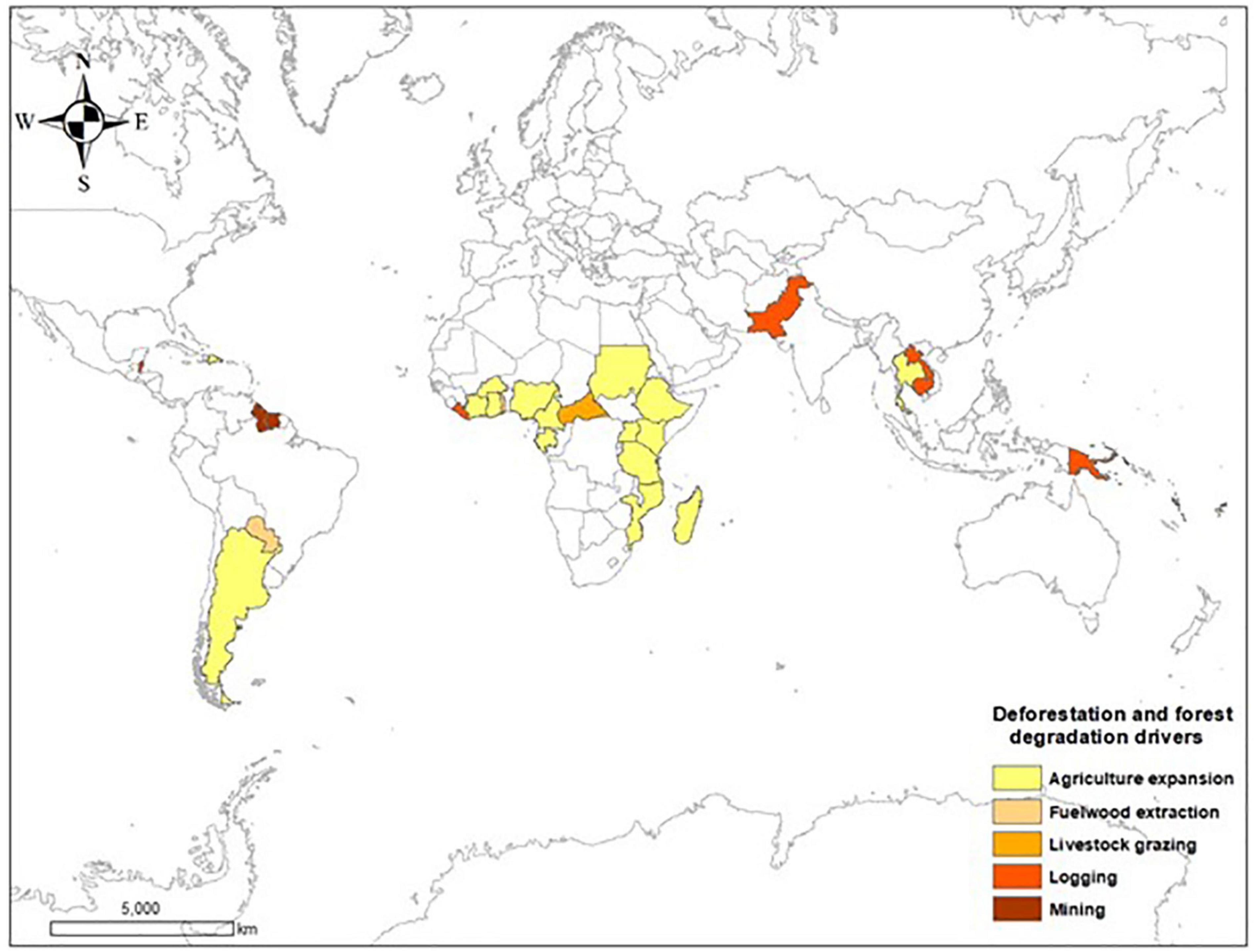
Figure 2. Main direct drivers of deforestation and forest degradation as described by policymakers in 29 participant countries’ R-PP.
Results
Figures 3–6 present the results of the content analysis. Figures 3, 4 show the frequency (%) of the direct drivers of deforestation and forest degradation across the 29 REDD+ participant countries studied, respectively, while Figure 2 shows the main deforestation and forest degradation drivers in each country. We found that agricultural expansion (54%) was the main driver of deforestation in the participating countries, followed by infrastructure development and mining, each with 23% (Figure 3), while logging (45%) was found to be the key direct driver of forest degradation, followed by fuelwood extraction (33%) and livestock grazing (22%) (Figure 3). Again, the results show that 62% of the participant countries had agricultural expansion as their main driver of deforestation, while 21% of the countries had logging as their number one driver of forest degradation. Only 7% of the countries had mining and fuelwood extraction as their main drivers, and 3% of the countries mentioned livestock grazing (Figure 2). These results support the argument made by Hosonuma et al. (2012) that agricultural expansion is an important deforestation driver in tropical developing countries, like logging for forest degradation. Olesen et al. (2018) revealed that agricultural expansion causes over 80% deforestation globally, 70% in Asia, and over 90% in the Americas. Kissinger et al. (2012) argued that the importance of agricultural expansion varies geographically when comparing commercial and subsistence agriculture. Most of the participant countries are agriculture-based economies, thereby expanding agricultural lands for crop production to meet domestic and international demand and enhance economic growth, leading to massive forest loss. For instance, in Ghana, cocoa expansion is a major contributor to deforestation (Oduro, 2016; Acheampong et al., 2019). The country loses approximately 135,000 ha of forest land annually for cocoa production. This is unacceptable because Ghana is a signatory to the “Participation Agreement” to achieve REDD+.
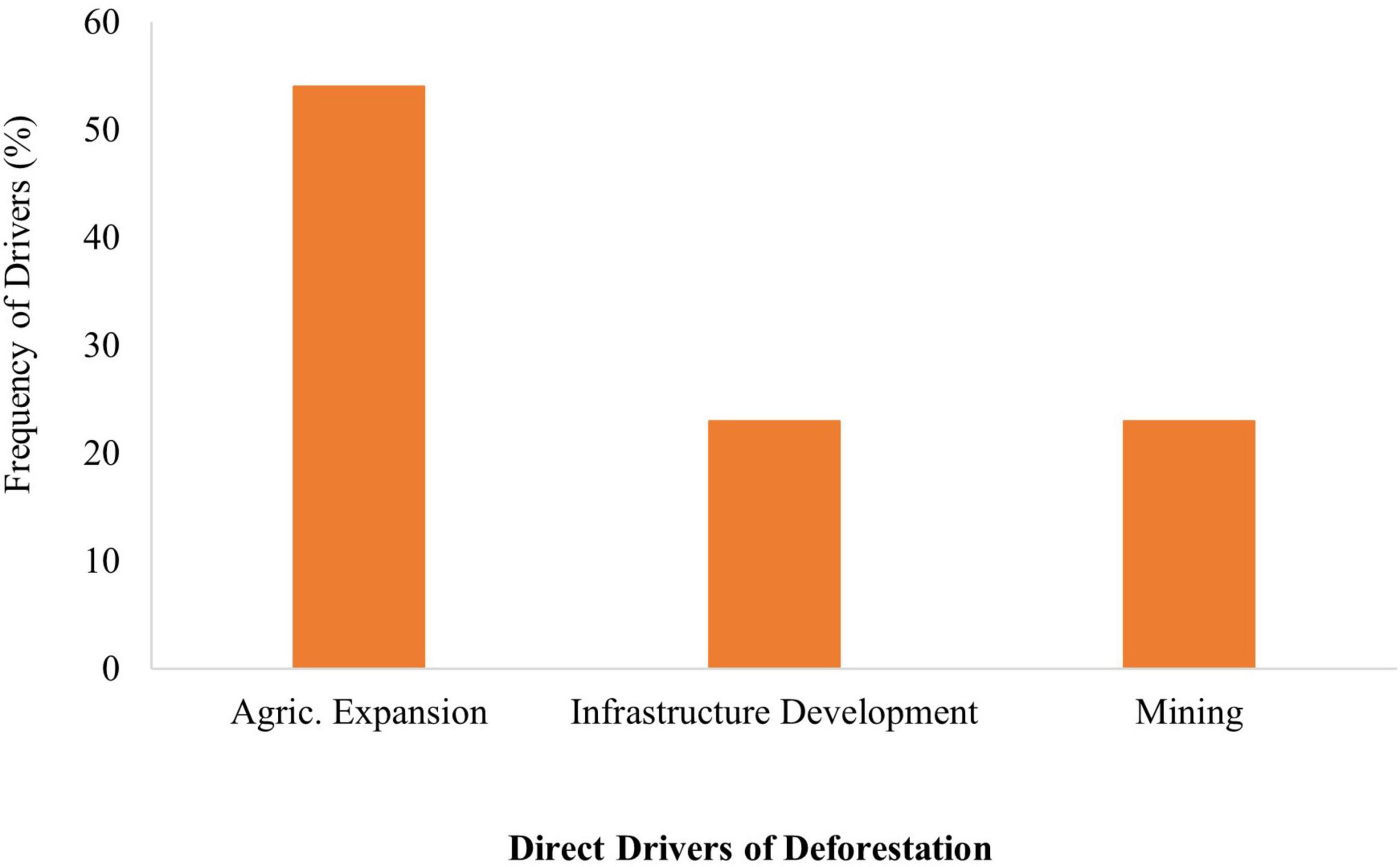
Figure 3. Direct deforestation drivers in 29 participant countries according to policymakers’ accounts.
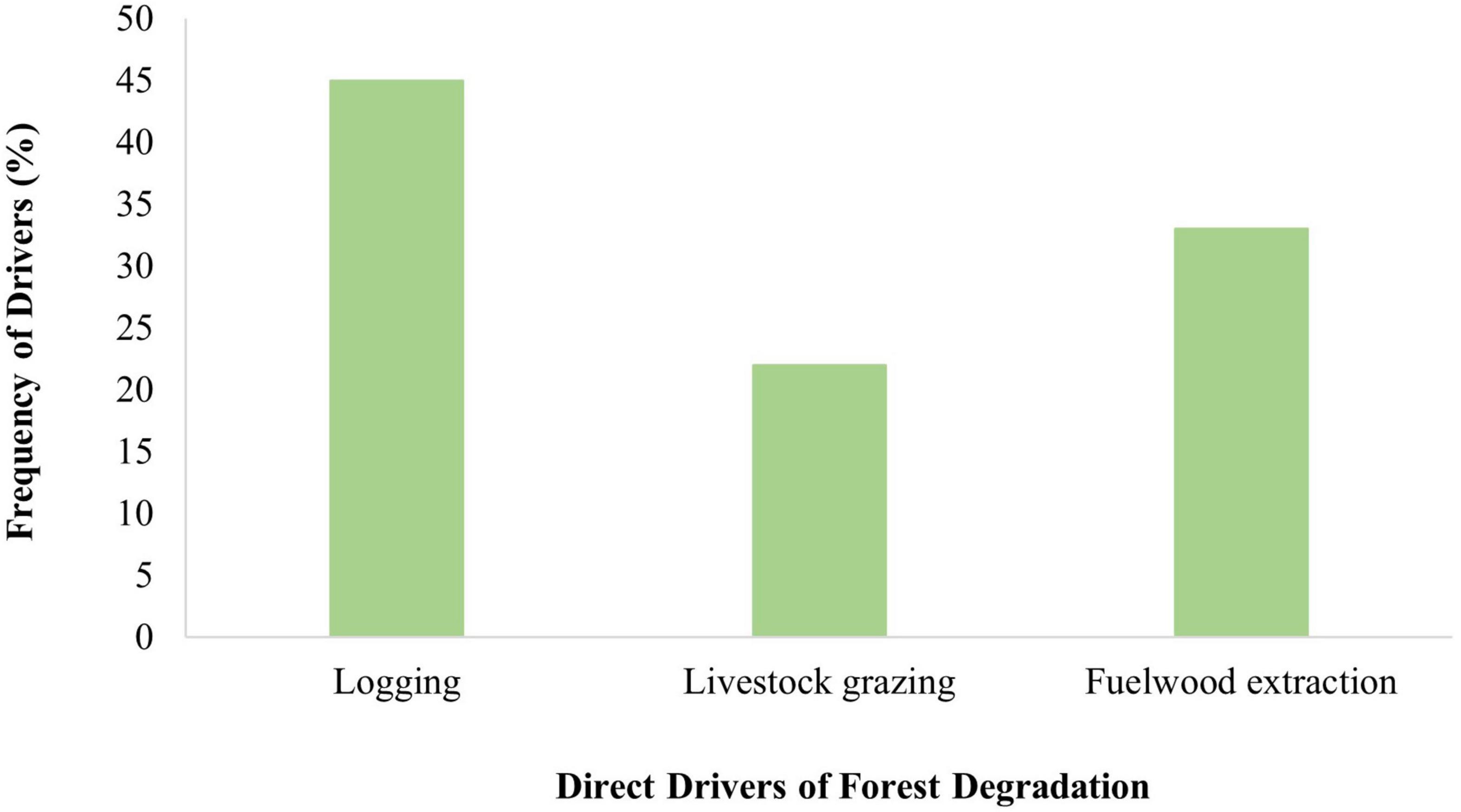
Figure 4. Direct forest-degradation drivers specified in 29 participant countries’ R-PPs as per policymakers’ accounts.
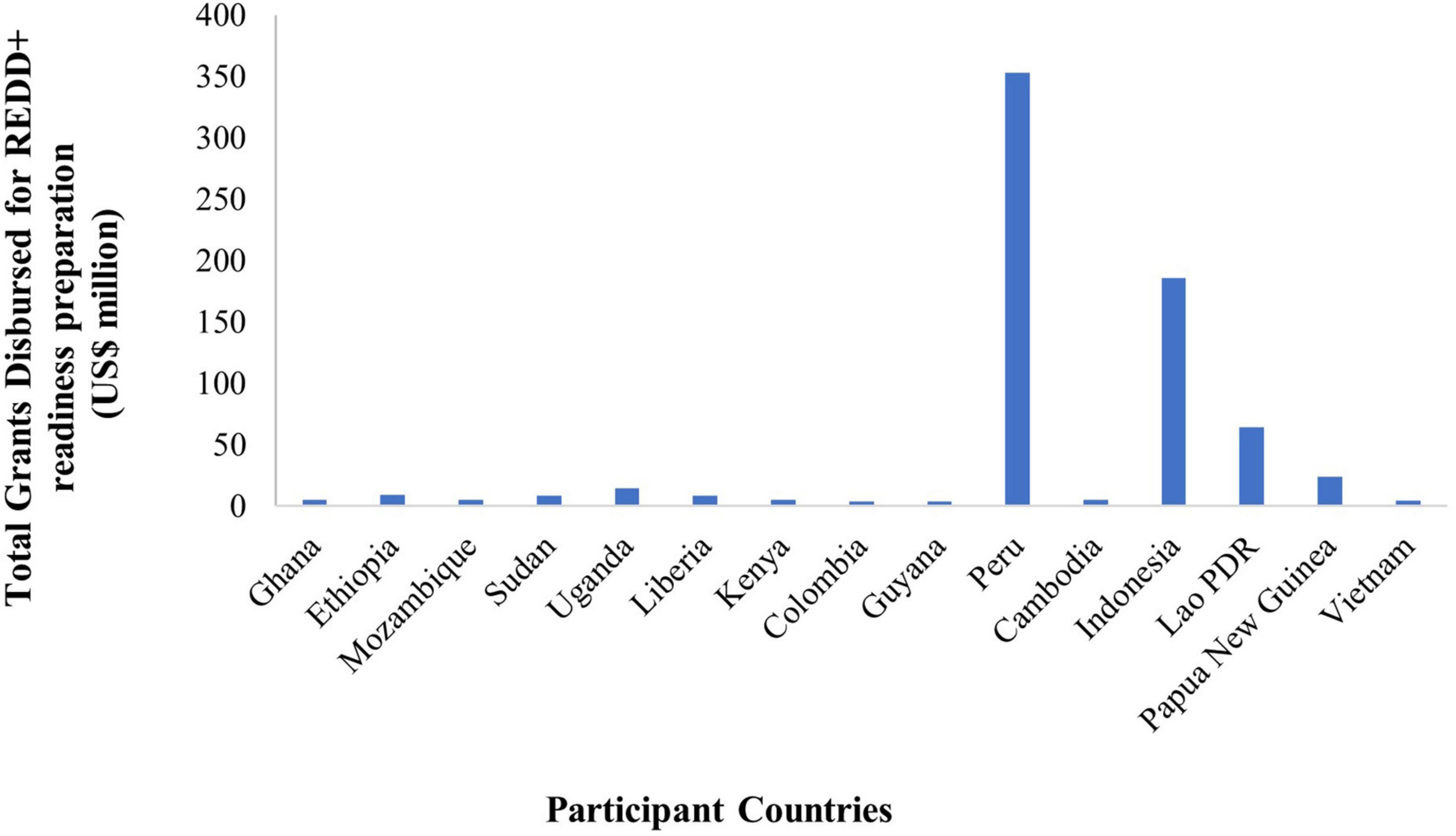
Figure 5. Total amount of grants received from FCPF by participant countries for REDD+ readiness preparation since R-PP was signed.
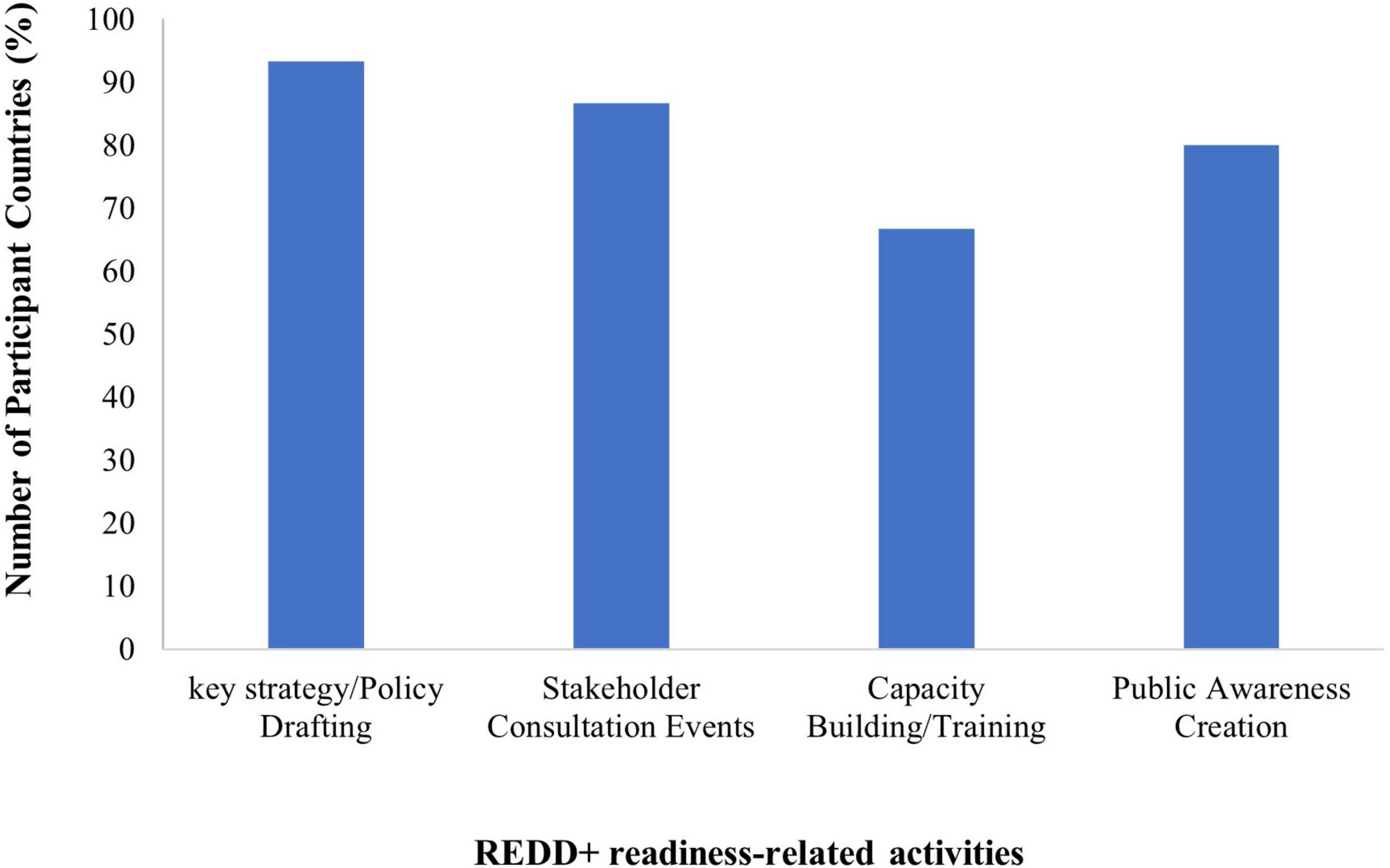
Figure 6. Percentage of participant countries and the REDD+ readiness-related activities being supported with funds secured from FCPF.
Figure 5 shows funds given to each participant country since they signed their R-PP. The result shows that a total of USD 0.7 billion has been disbursed to the 15 participant countries for REDD+ readiness preparation from the FCPF. However, the amounts received for REDD+ readiness preparation from the FCPF vary greatly across participant countries. Peru remarkably has received USD 0.35 billion, about 50% of the total grants, followed by Indonesia, with close to USD 0.2 billion. The third highest recipient is the Lao PDR, with over USD 64 million. However, grants received by other participant countries such as Ghana and Ethiopia fall below USD 50 million. For instance, in Ghana, USD 5.2 million was disbursed for the REDD+ readiness activities. In comparison, the total grant received by participant countries from Asia was USD 285 million, which is five times higher than the total grant disbursed to countries from sub-Saharan Africa—approximately USD 57 million. The amounts in Figure 5 are raw figures reported by the countries with no adjustment for inflation and others.
Figure 6 shows the funds spent on REDD+ readiness-related activities by participant countries. The results show that 93% of the participating countries supported activities such as the development of key strategic documents or policy drafts for REDD+, while 87% spent funds on stakeholder consultation events, and 68 and 80% of the 15 participating countries financially supported capacity building or training, and public awareness creation, respectively. The results show that only Kenya has no evidence of financial support for the REDD+ readiness-related activities assessed (Figure 7), although it has received about USD 5 million for readiness preparation. This is because Kenya’s REDD+ readiness activities supported by the FCPF have yet to be initiated. All participating countries invested in capacity building or training, except for Uganda, Kenya, Guyana, and Peru. Countries such as Uganda and Colombia did not specify whether public awareness creation activities were conducted and supported by the readiness fund. In Figure 7, less than 35% of the participating countries, including Ghana, Ethiopia, Liberia, Cambodia, and Indonesia, have developed the five key strategies and systems necessary for REDD+ implementation. Most countries have developed a national REDD+ strategy, which is a comprehensive strategy for controlling the drivers of deforestation and forest degradation as well as ensuring sustainable forest management. However, some countries are yet to put other systems in place, such as NFMS, FRL/FREL, MRV, and SIS, for the effective and efficient implementation of REDD+.
Discussion
Dominant drivers of deforestation and forest degradation in participant countries
Identifying the drivers of deforestation and forest degradation is fundamental to ensure that REDD+ is effective in participant countries. Through extensive consultations and stakeholder engagements, national policymakers in participant countries have specified the various direct and indirect factors causing deforestation and forest degradation. This shows that participant countries are visibly trying to adhere to several Cancun safeguard principles such as respecting, protecting, and fulfilling the rights of relevant stakeholders to participate in the design and implementation of REDD+ actions and promote adequate participatory procedures for local communities. Local communities are important for REDD+ readiness and implementation since their full participation will strengthen forest governance.
Our analysis of the R-PPs revealed that most participant countries have agricultural expansion, that is, commercial and subsistence agriculture, as the main driver of deforestation, while many consider logging (industrial and small-scale exploitation) as the dominant driver of forest degradation. The participant countries have proposed measures to address these drivers. Ghana, for instance, seeks to limit unsustainable agriculture expansion, illegal mining activities, and infrastructure development (Ghana Forestry Commission, 2016). Indonesia also has measures to control forest fires, conserve biodiversity, rehabilitate forests, and improve the watershed capacity as well as empowering forest fringe communities to sustainably manage forests (Gené, 2012). Some studies have advocated agricultural intensification to improve the yield and tackle deforestation (Pirard and Belna, 2012; Phelps et al., 2013; Acheampong et al., 2019). However, other studies, such as Rudel et al. (2009) and Boucher et al. (2011), indicate that agricultural intensification will even cause more deforestation in some situations. There should be much education and public awareness, especially for stakeholders in the agricultural sector, to better understand their role in contributing to deforestation and carbon emissions. Some of the readiness funds from bilateral and multilateral mechanisms can be channeled into public education at national, regional, and local levels to raise awareness of the negative effects of agricultural expansion and other drivers of deforestation and forest degradation on the global environment (e.g., climate change and biodiversity). Most local people involved in subsistence agriculture, illegal logging, and mining activities have low income levels and a lack of education and do not heed the environmental concerns of state agencies and non-governmental organizations. Policy interventions such as agroforestry to sustainably manage forests may even prove futile because of the potential low adoption rate among local farmers due to the low level of education and unwillingness to change. Kiyani et al. (2017) argued that some local farmers in Rwanda declined the adoption of agroforestry practices due to low capital, lack of education, and lack of skills, among others. Therefore, governments and private organizations need to collaborate to provide more capital and technical know-how to local farmers with strict supervision and regulation to increase the yield without affecting the forests. Again, some of the REDD+ countries such as Ghana have outlined strategic options to address the different drivers, such as ensuring that cocoa farmers adopt cocoa-smart agriculture to minimize cocoa expansion, enforcing timber legality compliance, improving tenure regimes, and securing benefit rights, as well as addressing unsustainable timber harvesting.
Total funds disbursed to participant countries
Secondly, this study finds that participant countries have received a total grant of approximately USD 0.7 billion from the FCFP to support their REDD+ readiness activities. However, the grants disbursed to each participant country differed, ranging from USD 5 million to USD 353 million (Figure 5). Countries such as Ethiopia, Ghana, Liberia, and Cambodia have received relatively small amounts of money for REDD+ readiness-related activities, despite their potential to achieve REDD+ (Olesen et al., 2018). They conducted key readiness activities such as developing strategies including NRS, NFMS, FRL/FREL, MRV, and SIS (Figure 7), organized stakeholder engagements, held capacity-building and training workshops, created public awareness through various platforms (Table 3), and were ready for full implementation, which would go a long way to having a positive impact on the identified drivers of deforestation and forest degradation in these countries, such as agriculture, logging, mining, infrastructure development, and fuelwood extraction. Setting up an NFMS with funds received would help the countries to monitor REDD+ activities and provide reliable information on their forests, which is critical to address deforestation and degradation and mitigate climate change. The small amounts of funds to the participating countries indicated above were shown in Olesen et al. (2018) finding that donors are providing funding for REDD+ not necessarily because of the recipient country’s potential to reduce carbon emissions but rather because of bilateral relations. For instance, Brazil and Norway signed a bilateral deal of USD 1 billion for REDD+ in 2008, of which, by 2014, about USD 867 million had been disbursed (Silva-Chávez et al., 2015), contributing to the larger amount thus far disbursed to a country. Disbursed funds, which are insufficient, are susceptible to change due to politics, public views, and economic interests among stakeholders (Wolosin and Lee, 2014; Angelsen, 2017). We argue that participant countries should strengthen and establish more bilateral relations through effective cooperation to enhance their political, social, and economic ties with donor countries. This would provide some assurance of grants for REDD+ programs. Beyond this, participant countries need to build the capacities of local communities around forest frontiers to protect and manage forests sustainably.
Funding was provided to help participant countries prepare and implement REDD+ activities. Therefore, inadequate funds for REDD+ activities may slow the progress of REDD+ implementation. The low disbursement rates to participant countries, especially in sub-Saharan Africa, should be a concern for governments and donors. Donors need to assist participant countries in building effective governance structures and institutional capacity to attract and manage large funds that may be disbursed for REDD+. Again, countries with high potential to reduce carbon emissions need to be encouraged with more financial incentives coupled with a strong regulatory framework to reduce malfeasance in the REDD+ policy process. In addition, participant countries need to look beyond bilateral and multilateral financial mechanisms and mobilize domestic resources such as private investors and social capital at the national, regional, and local levels for REDD+ implementation.
Readiness activities supported with funds disbursed
Stakeholder engagements
Finally, this study shows that all 15 participant countries, in one way or another, have financed various activities essential to REDD+. Stakeholder engagement is important for obtaining the buy-in of all relevant parties for the successful implementation of REDD+. It is a process whereby all stakeholders meet to listen to or deliberate on issues surrounding a policy, program, or project to gain a better understanding to build trust and confidence, as well as garnering support for its implementation. In this study, 87% of the participating countries held stakeholder engagement events at national and local levels. Sudan organized stakeholder engagements and consultations for a total of 11,165 stakeholders, comprising 7,332 males and 3,833 females from various interest groups, to discuss topics on REDD+ safeguards, free grievance redress mechanisms, benefit sharing, and the role of women in the forestry sector. Cambodia also held multiple stakeholder engagements and consultations events for 962 men and 395 women on the development of action and investment plans for the implementation of the national REDD+ strategy and safeguards, among others. This balance of male and female participation in the various events shows participant countries’ efforts to ensure gender equality and women empowerment, which is in line with Sustainable Development Goal 5. Stakeholder engagement events, when conducted well, will allay the fears of uncertainty and encourage all parties to align with and support the REDD+ initiative. Atela et al. (2016) advocated a strong multi-stakeholder consultative mechanism for effective REDD+ implementation in Kenya.
Capacity building
Capacity-building/training activities were also financed by REDD+ funds. For example, in Ghana, REDD+ funds have been used to build the capacity of the national REDD+ secretariat through several training and capacity-building workshops. Other stakeholder groups have also directly benefited from capacity-building training aimed at enhancing their capacity to contribute to REDD+ implementation. In many participant countries, capacity-building activities support forest monitoring capabilities and functional MRV systems. This study finds that 68% of the 15 participant countries financed capacity-building activities. Our analysis shows that participant countries spent relatively small amounts of money on capacity-building/training activities compared to other REDD+ readiness-related activities. This is reflected in the finding by Olesen et al. (2018) that, globally, the proportion of REDD+ fund-supporting activities focused on MRV is very low (7%).
Conclusion
Many developing countries have expressed interest in implementing REDD+ under the UNFCCC arrangements to tackle their respective drivers of deforestation and forest degradation, and to reduce CO2 emissions and increase GHG removal. However, funding to support participant countries in preparing and implementing the REDD+ policy has become a challenge. Therefore, in this study, we examined the various drivers of deforestation and forest degradation in 29 REDD+ participant countries specified in the R-PPs to identify which drivers are predominant in each country for strategic policy and action, as well as suitable financial support. We also paid attention to the total funds secured by 15 participant countries since they signed their respective R-PPs from the FCPF and the REDD+ readiness-related activities they have spent the money on through content analysis. We found that the drivers of deforestation and forest degradation described by the countries’ policymakers are agriculture expansion, infrastructural development, mining, logging, livestock grazing, and fuelwood extraction. However, agricultural expansion, which includes commercial and subsistence agriculture, predominates as the main driver of deforestation, while logging, including industrial and small-scale exploitation, prevails as the main driver of forest degradation in most participant countries. In addition, this study revealed that the 15 participating countries received a total of USD 702.36 million for REDD+ readiness preparation. However, most countries have received less than USD 10 million for their readiness-related activities. This study observed a huge disparity regarding the funds received between countries from sub-Saharan Africa and their Asian and Latin American counterparts, particularly Indonesia and Peru, respectively. Countries such as Ethiopia, Ghana, Liberia, and Cambodia have received relatively small amounts of money for REDD+ readiness preparation. However, they have progressed significantly since the readiness phase and are ready to implement their strategies at the national and sub-national levels to achieve REDD+. Finally, we found that almost all the countries have spent their funds on policy and strategy development, stakeholder and consultation events, and public awareness creation, with lower amounts of funds spent on capacity building or training. Thus, it is important for participant countries to direct more attention to building their institutional capacities and forest governance structures for REDD+. Additionally, international donors need to provide platforms to engage more with participant countries to tackle their main deforestation and forest degradation drivers. We suggest that further studies should identify high-performing countries that have received lower-than-average funding, considering their deforestation pressures, the size of the forests, and the emission reduction potential.
Data availability statement
The original contributions presented in this study are included in the article/supplementary material, further inquiries can be directed to the corresponding author.
Author contributions
JA designed the study, collected the data, and performed the analysis of this study. JA and KO discussed the results. YL and JP supervised and directed the preparation of the manuscript. All authors revised and approved the final manuscript.
Funding
This work was supported by the New Faculty Startup Fund from Seoul National University. In addition, partially, this work was carried out with the support of “R&D Program for Forest Science Technology” (Project No. FTIS 2018112E10-2020-BB01) was provided by the Korea Forest Service through the Korea Forestry Promotion Institute.
Acknowledgments
We express our profound appreciation to all reviewers for their time and insightful comments, which helped reshape this work.
Conflict of interest
The authors declare that the research was conducted in the absence of any commercial or financial relationships that could be construed as a potential conflict of interest.
Publisher’s note
All claims expressed in this article are solely those of the authors and do not necessarily represent those of their affiliated organizations, or those of the publisher, the editors and the reviewers. Any product that may be evaluated in this article, or claim that may be made by its manufacturer, is not guaranteed or endorsed by the publisher.
References
Acheampong, E. O., Macgregor, C. J., Sloan, S., and Sayer, J. (2019). Deforestation is driven by agricultural expansion in Ghana’s forest reserves. Sci. Afr. 5:e00146. doi: 10.1016/j.sciaf.2019.e00146
Andoh, J., Chang, J. B., and Lee, Y. (2018). Analyzing the effect of socio-economic factors on deforestation using an environmental Kuznets curve model. Korean J. Agric. Econ. 59, 169–189.
Andoh, J., and Lee, Y. (2018). National REDD+ strategy for climate change mitigation: A review and comparison of developing countries. Sustainability 10:4781. doi: 10.3390/su10124781
Angelsen, A. (2017). REDD+ as result-based aid: General lessons and bilateral agreements of Norway. Rev. Dev. Econ. 21, 237–264. doi: 10.1111/rode.12271
Angelsen, A., Brockhaus, M., Sunderlin, W. D., and Verchot, L. V. (2012). Analyzing REDD+: Challenges and choices. Bogor: CIFOR.
Angelsen, A., Martius, C., De Sy, V., Duchelle, A. E., Larson, A. M., and Pham, T. T. (eds) (2018). Transforming REDD+: Lessons and new directions. Bogor: CIFOR.
Atela, J. O., Quinn, C. H., Minang, P. A., Duguma, L. A., and Houdet, J. A. (2016). Implementing REDD+ at the national level: Stakeholder engagement and policy coherences between REDD+ rules and Kenya’s sectoral policies. For. Policy Econ. 65, 37–46. doi: 10.1016/j.forpol.2016.01.003
Bastos-Lima, M. G., Visseren-Hamakers, I., Braña-Varela, J., and Gupta, A. (2017). A reality check on the landscape approach to REDD+: Lessons from Latin America. For. Policy Econ. 78, 10–20. doi: 10.1016/j.forpol.2016.12.013
Boucher, D., Elias, P., Lininger, K., May-Tobin, C., Roquemore, S., and Saxon, E. (2011). The root of the problem: What’s driving tropical deforestation today? The root of the problem: What’s driving tropical deforestation today? Cambridge, MA: Union of Concerned Scientists.
Brink, A. B., and Eva, H. D. (2009). Monitoring 25 years of land cover change dynamics in Africa: A sample based remote sensing approach. Appl. Geogr. 29, 501–512. doi: 10.1016/j.apgeog.2008.10.004
Brockhaus, M., Korhonen-Kurki, K., Sehring, J., and Di Gregorio, J. (2015). Policy progress with REDD+ and the promises of performance-based payments: A qualitative comparative analysis of 13 countries, Vol. 196. Bogor: CIFOR.
Cadman, T., Maraseni, T., Ma, H. O., and Lopez-Casero, F. (2017). Five years of REDD+ governance: The use of market mechanisms as a response to anthropogenic climate change. For. Policy Econ. 79, 8–16. doi: 10.1016/j.forpol.2016.03.008
DeFries, R. S., Rudel, T., Uriarte, M., and Hansen, M. (2010). Deforestation driven by urban population growth and agricultural trade in the twenty-first century. Nat. Geosci. 3:178. doi: 10.1038/ngeo756
Duchelle, A. E., de Sassi, C., Jagger, P., Cromberg, M., Larson, A. M., Sunderlin, W. D., et al. (2017). Balancing carrots and sticks in REDD+: Implications for social safeguards. Ecol. Soc. 22:2. doi: 10.5751/ES-09334-220302
FCPF (2017). REDD+ participant countries readiness preparation proposals (R-PPs). Available online at: https://www.forestcarbonpartnership.org/country (accessed July 17, 2017).
Fischer, R., Hargita, Y., and Gunter, S. (2016). Insights from the ground level? A content analysis review of multi-national REDD+ studies since 2010. For. Policy Econ. 66, 47–58. doi: 10.1016/j.forpol.2015.11.003
Fisher, B. (2010). African exception to drivers of deforestation. Nat. Geosci. 3:375. doi: 10.1038/ngeo873
Fujisaki, T., Hyakumura, K., Scheyvens, H., and Cadman, T. (2016). Does REDD+ ensure sectoral coordination and stakeholder participation? A comparative analysis of REDD+ national governance structures in countries of Asia-Pacific region. Forests 7:195. doi: 10.3390/f7090195
Geist, H. J., and Lambin, E. F. (2001). What drives tropical deforestation? A metal analysis of proximate and underlying causes of deforestation based subnational case study evidence. Louvain-la-Neuve: LUCC International Project Office, 116.
Geist, H. J., and Lambin, E. F. (2002). Proximate causes and underlying driving forces of tropical deforestation. Tropical forests are disappearing as the result of many pressures, both local and regional, acting in various combinations in different geographical locations. BioScience 52, 143–150. doi: 10.1641/0006-3568(2002)052[0143:PCAUDF]2.0.CO;2
Hein, J., Guarin, A., Frommé, E., and Pauw, P. (2018). Deforestation and the Paris climate agreement: An assessment of REDD+ in the national climate action plans. For. Policy Econ. 90, 7–11. doi: 10.1016/j.forpol.2018.01.005
Hosonuma, N., Herold, M., De Sy, V., De Fries, R. S., Brockhaus, M., Verchot, L., et al. (2012). An assessment of deforestation and forest degradation drivers in developing countries. Environ. Res. Lett. 7:044009. doi: 10.1007/s11356-021-12806-z
Gené, E. I. (2012). Indonesia REDD+ readiness: State of Play. Hayama: Institute for Global Environmental Strategies (IGES).
IPCC (2020). Achieving co-benefits through managing land and climate risks IPCC special report on climate change and land. Geneva: IPCC.
Jha, S., and Bawa, K. S. (2006). Population growth, human development, and deforestation in biodiversity hotspots. Conserv. Biol. 20, 906–912. doi: 10.1111/j.1523-1739.2006.00398.x
Karsenty, A., and Ongolo, S. (2012). Can “fragile states” decide to reduce their deforestation? The inappropriate use of the theory of incentives with respect to the REDD mechanism. For. Policy Econ. 18, 38–45. doi: 10.1016/j.forpol.2011.05.006
Kissinger, G., Herold, M., and De Sy, V. (2012). Drivers of deforestation and forest degradation: A synthesis report for REDD+ policymakers. Vancouver, BC: Lexeme Consulting.
Kiyani, P., Andoh, J., Lee, Y., and Lee, D. K. (2017). Benefits and challenges of agroforestry adoption: A case of Musebeya sector, Nyamagabe district in southern province of Rwanda. For. Sci. Technol. 13, 174–180.
Laporte, N. T., Stabach, J. A., Grosch, R., Lin, T. S., and Goetz, S. J. (2007). Expansion of industrial logging in central Africa. Science 316, 1451–1451.
Mayring, P. (2014). Qualitative content analysis: Theoretical foundation, basic procedures and software solution. Klagenfurt: Social Science Open Access Repository.
Minang, P. A., Van Noordwijk, M., Duguma, L. A., Alemagi, D., Do, T. H., Bernard, F., et al. (2014). REDD+ readiness progress across countries: Time for reconsideration. Clim. Policy 14, 685–708.
Norman, M., and Nakhooda, S. (2014). The state of REDD+ finance. Washington, DC: Center for Global Development.
Ochieng, R. M., Arts, B., Brockhaus, M., and Visseren-Hamakers, I. J. (2018). Institutionalization of REDD+ MRV in Indonesia, Peru, and Tanzania. Ecol. Soc. 23:8.
Oduro, K. A. (2016). Ghana’s high forests: Trends, scenarios and pathways for future developments. Ph.D. thesis. Wageningen: Wageningen University. doi: 10.18174/378343
Olesen, A., Böttcher, H., Siemons, A., Herrmann, L., Martius, C., Roman-Cuesta, R. M., et al. (2018). Study on EU financing of REDD+ related activities, and results-based payments pre and post 2020: Sources, cost-effectiveness and fair allocation of incentives. Luxembourg: European Commission, DG Environment/Climate Action.
Pacheco, P., Putzel, L., Obidzinski, K., and Schoneveld, G. (2012). “REDD+ and the global economy: Competing forces and policy options,” in Analyzing REDD+: Challenges and choices, eds A. Angelsen, M. Brockhaus, W. D. Sunderlin, and L. V. Verchot (Bogor: CIFOR).
Phelps, J., Carrasco, L. R., Webb, E. L., Koh, L. P., and Pascual, U. (2013). Agricultural intensification escalates future conservation costs. PNAS 110, 7601–7606. doi: 10.1073/pnas.1220070110
Pirard, R., and Belna, K. (2012). Agriculture and deforestation: Is REDD+ rooted in evidence? For. Policy Econ. 21, 62–70
PNG R-PP (2013). Papua new guinea readiness preparation proposal submitted to forest carbon partnership facility. Available online at: https://www.forestcarbonpartnership.org/country-png/ (accessed March 15, 2018).
Rademaekers, K., Eichler, L., Berg, J., Obersteiner, M., Havlik, P., Aioki, K., et al. (2010). Study on the evolution of some deforestation drivers and their potential impacts on the costs of an avoiding deforestation scheme. Brussels: European Commission.
Romijn, E., Lantican, C. B., Herold, M., Lindquist, E., Ochieng, R., Wijaya, A., et al. (2015). Assessing change in national forest monitoring capacities of 99 tropical countries. For. Ecol. Manag. 352, 109–123.
Rudel, T. K., Schneider, L., Uriarte, M., Turner, B. L., DeFries, R., Lawrence, D., et al. (2009). Agricultural intensification and changes in cultivated areas, 1970–2005. Proc. Natl. Acad. Sci. U.S.A. 106, 20675–20680. doi: 10.1073/pnas.0812540106
Sanford, T. J., Boucher, D., Elias, P., Lininger, K., May-Tobin, C., and Roquemore, S. (2011). “The drivers of tropical deforestation: A comprehensive review,” in Proceeding of the AGU fall meeting abstracts, Vol. 1, (Washington, DC: American Geophysical Union), 1087 doi: 10.1002/ecy.3301
Silva-Chávez, G., Schaap, B., and Breitfeller, J. (2015). Redd+ finance flows 2009-2014: Trends and lessons learned in REDDX countries. Washington, DC: Forest Trends.
Streck, C. (2012). Financing REDD+: Matching needs and ends. Curr. Opin. Environ. Sustain. 4, 628–637.
UNFCCC (2010). Outcome of the work of the ad hoc working group on long-term cooperative action under the convention policy approaches and positive incentives on issues relating to REDD+ in developing countries. New York, NY: UNFCCC.
Weatherley-Singh, J., and Gupta, A. (2015). Drivers of deforestation and REDD+ benefit-sharing: A meta-analysis of the (missing) link. Environ. Sci. Policy 54, 97–105.
Wehkamp, J., Aquino, A., Fuss, S., and Reed, E. W. (2015). Analyzing the perception of deforestation drivers by African policy makers in light of possible REDD+ policy responses. For. Policy Econ. 59, 7–18.
Keywords: drivers of deforestation and forest degradation, REDD+, readiness preparation proposal (R-PP), funding, stakeholder engagement, participant country
Citation: Andoh J, Oduro KA, Park J and Lee Y (2022) Towards REDD+ implementation: Deforestation and forest degradation drivers, REDD+ financing, and readiness activities in participant countries. Front. For. Glob. Change 5:957550. doi: 10.3389/ffgc.2022.957550
Received: 31 May 2022; Accepted: 30 September 2022;
Published: 18 October 2022.
Edited by:
Emmanuel F. Nzunda, Sokoine University of Agriculture, TanzaniaReviewed by:
Moira Moeliono, Center for International Forestry Research (CIFOR), IndonesiaElikana John, Tanzania Forest Services Agency, Tanzania
Copyright © 2022 Andoh, Oduro, Park and Lee. This is an open-access article distributed under the terms of the Creative Commons Attribution License (CC BY). The use, distribution or reproduction in other forums is permitted, provided the original author(s) and the copyright owner(s) are credited and that the original publication in this journal is cited, in accordance with accepted academic practice. No use, distribution or reproduction is permitted which does not comply with these terms.
*Correspondence: Yohan Lee, am9obmxlZUBzbnUuYWMua3I=
 Jewel Andoh
Jewel Andoh Kwame Antwi Oduro1
Kwame Antwi Oduro1 Yohan Lee
Yohan Lee